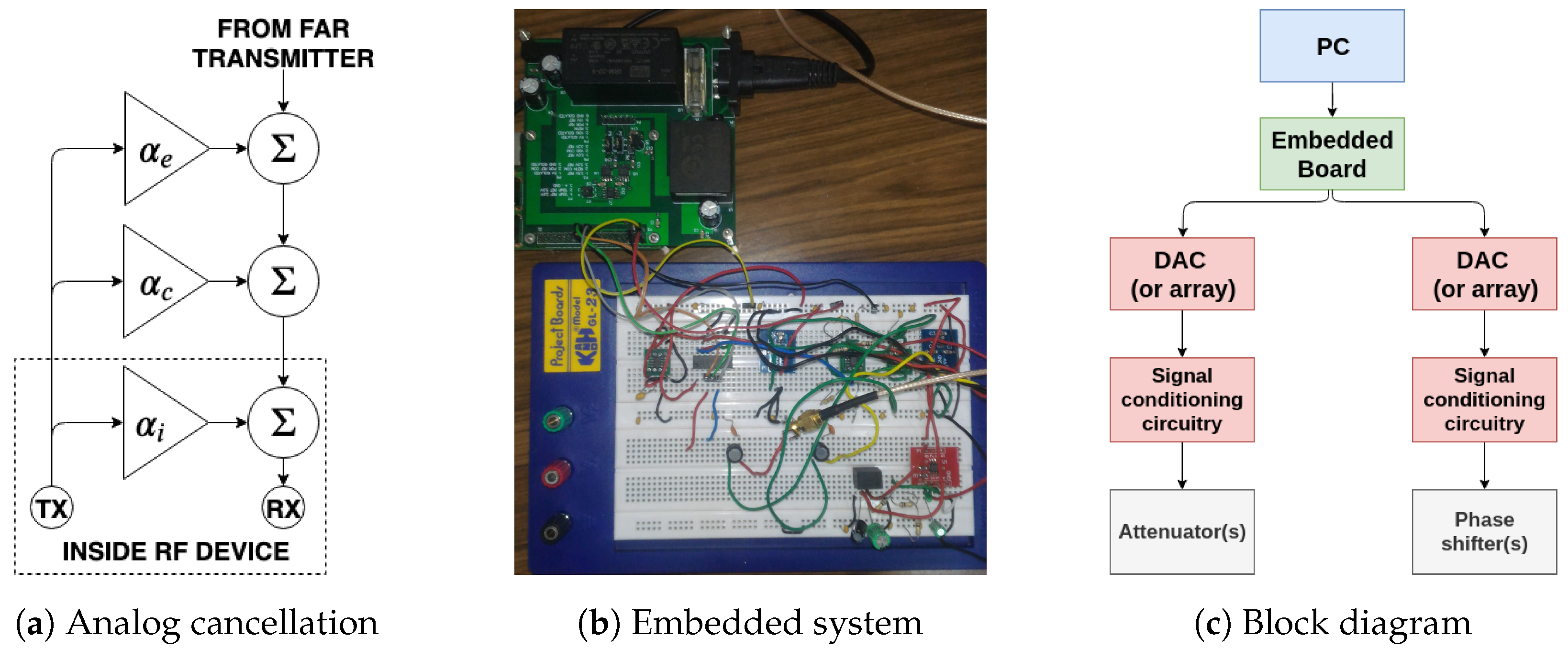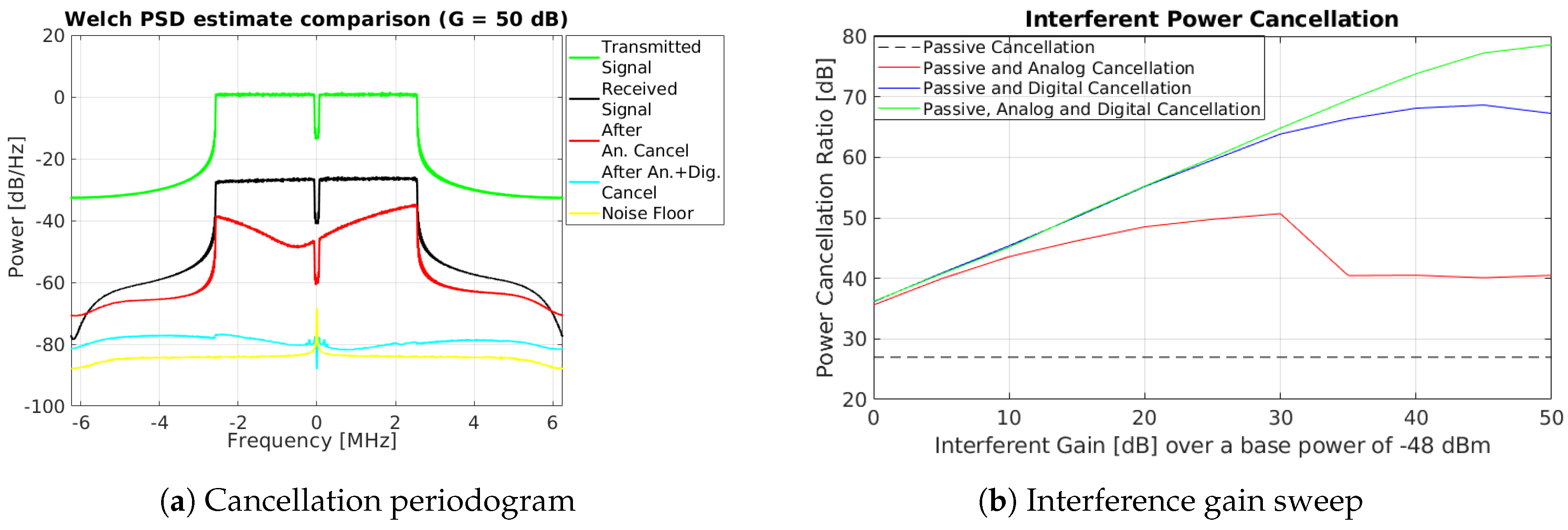1. Introduction
Traditional communication systems are based on a half-duplex scheme, in which a transmitting node sends information to a receiver node through a specific channel. Using this scheme, it is necessary to use some sort of multiplexing, either in time domain or in frequency domain, to allow transmission and reception when it is needed that both tasks are performed simultaneously. These schemes are no longer valid in an environment where an increasing number of applications are demanding bandwidth from a limited electromagnetic spectrum. In-band full-duplex almost doubles spectral efficiency comparing to traditional multiplexed schemes, as shown in
Figure 1.
In [
1], a wide variety of topologies of in-band full-duplex are presented. However, the common challenge involving full-duplex development is self-interference. According to results shown in literature [
1,
2], self-interference power level should be below the noise floor or, alternatively, more than 70 dB of self-interference cancellation are needed to be able to recover information from a far transmitter troublelessly. In addition to that, self-interference signal has enough power to strongly saturate both RF front-end and converters at the receiver side. Thus, recovering information signal becomes an impossible task, and potential stress due to overpower may even damage electronic components.
2. Design
In order to solve self-interference issues, we propose the usage of a hybrid multi-stage cancellation system, consisting of an analog cancellation setup at RF frequencies following the so-called Stanford architecture, and a base-band digital cancellation stage.
The aim of building an analog cancellation setup is performing a first power reduction of self-interference signal so that receiver analog front-end interface will not be saturated or damaged. A real-hardware full-duplex setup may suffer from two main sources of self-interference, as shown in
Figure 2a: internal coupling (
, signal power fraction that leaks between transmission and reception interfaces of most radio platforms), and external coupling (
, fraction of RF transmitted signal that leaks into the receiver chain through the antenna interface). For attenuating interference, a parallel branch (
) is introduced. The ideal value for this branch is the counterphase replica of the sum of the internal and external coupling signals, that is,
. With this value, self-interference would disappear. The parallel branch is based on a small network consisting of a set of voltage-variable attenuators and phase shifters, controlled from a PC through an embedded-system-based design, as shown in
Figure 2b. Values of attenuation and phase to be generated by the RF devices network are calculated iteratively. These values are then transposed into codes by the embedded system and sent to the DACs (Digital-to-Analog Converters), so that the network can perform a real-time adaptation to changes in coupling.
Finally, digital cancellation performs the main interference removal task. The objective of digital cancellation is reducing the self-interference power to below the noise floor. Both LMS (Least Mean Squares) [
3] and APA (Affine Projection Algorithm) [
4] methods have been implemented to compare the cancellation ratio in both cases.
3. Implementation
This cancellation system has been implemented and tested in two Software Defined Radio platforms (USRP N210) using a custom made application over UHD API driver. RF parallel branch is built using off-the-shelf attenuators, phase shifters and RF splitters. RF gains higher than 30 dB were generated including a pair of LNAs (Low Noise Amplifiers, fixed 34 dB). Transmitted symbols have been generated using a QPSK constellation, then modulated using OFDM (Orthogonal Frequency-Division Multiplexing) with N = 512 subcarriers. Cyclic prefix length is 32 symbols, bandwidth used is 5 MHz, and sampling frequency is 12.5 MHz. Resulting stream is then upconverted to 900 MHz band.
4. Results
The base transmission signal, without any RF gain, has a power level of −48 dBm for these experiments. On the one hand, for results shown in
Figure 3a, a RF gain of 50 dB is applied. Lines are Welch periodograms: yellow line, of the noise floor; green line, of the transmitted self-interference signal; black line, of the raw self-interference received signal; and red and blue lines, of the same received signal after analog cancellation and analog plus digital cancellation respectively. It can be seen that cancellations can lower self-interference signal power about 80 dB. LMS and APA algorithms perform similarly in terms of cancellation. On the other hand, for results shown in
Figure 3b, a self-interference RF gain sweep has been performed. It can be seen that cancellation ratio grows in a linear proportional way with interference gain, so self-interference power level is below noise floor with lower values of RF interference gain. These results show that measured performance is enough to recover signal from a far transmitter. Besides, performance in terms of MER measured using this full-duplex scheme is comparable to the one measured using a traditional half-duplex scheme.
5. Conclusions
Up to 80 dB of power interference cancellation can be achieved with a full-duplex OFDM scheme. The results show that is possible to perform a frequency-efficient full-duplex communication using mostly off-the-shelf components. This system can recover the original message with a MER level that is comparable to the one achieved with traditional half-duplex schemes. Some applications getting benefit from this new full-duplex approach are cognitive radio systems, MIMO, WiFi, 5G, and high-demanding Internet of Things applications and satellite communications.







